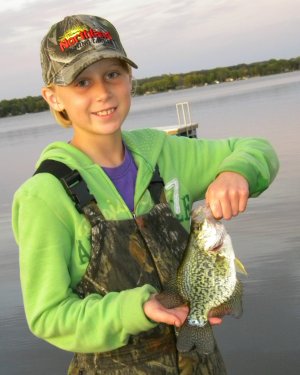
I am a tournament angler and fishing guide. Yet some of my favorite fishing trips occur every spring when my daughter Hannah and I share a boat or bank catching early-season crappies. These fish are often pretty easy to find and can provide exciting fishing action. Just what eager anglers need after a long winter of open-water anticipation!
Spring crappies make shallow water migrations to feed and later to spawn. One good thing about this fishing is that some of the shallow areas they migrate to are accessible by shore anglers. Marinas, canals, and shallow bays warm quickly in the spring drawing crappies. Some of these spots are spots anglers can access without a boat.
Easy access to fishing spots is one advantage of spring crappie angling. Another is that the peak bite in some of these spots is often right before dark, meaning a quick end-of-the-day trip can often be very productive.
Not only is spring crappie location often a pretty simple affair, but so is the presentation that catches these fish. A small jig fished below a Lite-Bite Slip Bobber tipped with a crappie minnow is a favorite. A pink/white or glow green 1/32-ounce Gypsi Jig tipped with a small, but very lively crappie minnow is my favorite crappie set-up. Gypsi Jigs have tinsel tails that give off a fish scale flash that really attracts spring crappies. A small split shot added about a foot above the jig completes the system. I like the pink/white color jig combination for daytime fishing, switching to the glow green color during low light conditions.
Gypsi Jigs have produced good spring crappie catches for years. Last year another jig, the Bug-A-Boo Jig produced crappies as well. These jigs feature marabou feathers that pulsate and quiver to attract and trigger crappies and have quickly become another option in my fish-catching arsenal.
Regardless of which jig is chosen, an important factor in making this simple system the most effective is the use of the right bobber. The Super-Pro Lite-Bite Slip Bobbers are awesome tools for this fishing. They have hi-vis stems that can be seen easily in low light. Not only that, but the bobber stems have Slip-N-Slide grommets allowing the line to slide through with minimal resistance helping anglers catch light biters. Their sleek pear shape also helps anglers in bite detection.
The final component of this presentation revolves around the right rod/reel/line combination. Small jigs fished below bobbers fish well on light line. I’ve often wavered between 2- and 4-pound test monofilament, feeling I get more bites on the 2-pound test, but being leery of breaking off a slab crappie on the way to the boat when using this line size.
Not only that, Bionic Line handles extremely well and is available in a blue camo color pattern that blends into the blue sky background which can be important for upward feeding crappies holding in clear water. A 7-foot light action spinning rod and reel combination completes my spring crappie set-up. This combination allows for long casts letting me cover lots of water in my search of likely crappie haunts.
Heading to a likely crappie-holding spot on one of spring’s first nice days is something I look forward to every year. Using the simple tips above often leads to spring crappie success for Hannah and me and can probably lead to success for other anglers as well. As always, good luck on the water!

